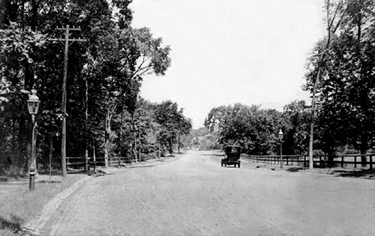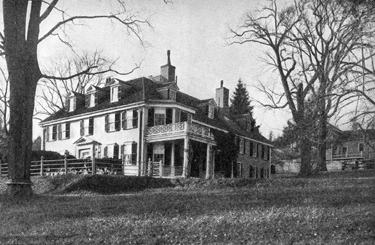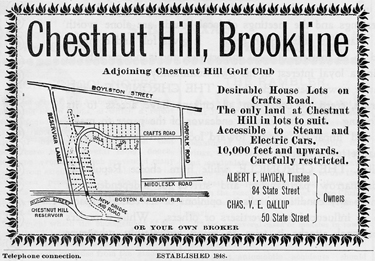Chestnut Hill is defined by its zip code and history. At one time considered remote to Boston, the settlement first formed around a train station, eventually establishing its identity as a community. Named by Francis Lee, who built the first country house in the area in the 1850's, Chestnut Hill is in three different towns (Brighton, Brookline, and Newton) and two different counties (Norfolk and Middlesex). Like other neighborhoods in Brookline, for instance Longwood and Cottage Farm, Chestnut Hill began as a neighborhood for friends and family of the original landowners. While it is now surrounded by continuous suburban development, with a little imagination we can picture it as a distant outpost from Boston, appealing to wealthy professionals and businessmen seeking a country retreat in a neighborhood of peers.
Chestnut Trees
Substantial change had already altered the lands of Chestnut Hill a century before wealthy Bostonians set their sights on a house in the country. By the mid 1700's, the original landscape of meadows and wetlands had been converted to large farms and woodlots in the ownership of a few prominent families. True to its name, a stand of chestnut trees stretched from Dunster Street to Reservoir Lane. A significant structure of the era, Richards Tavern, was built in 1760 on Heath Street near Hammond. An evangelical revival group, the "New Lights", helped construct the building and held their services there. The property included a tollgate for the Worcester Turnpike, thereby capturing income from travelers.

Because large parcels of land were sold and subdivided all at once, the neighborhoods of Chestnut Hill have a pleasing uniformity to them. Large, gracious homes were designed and built in the styles popular at the turn of the century, such as Colonial Revival, Tudor, and Shingle Style. They were then carefully sited on large lots that were heavily wooded. There is a continuity of styles, scale, setting, and materials amongst the homes that lends aesthetic cohesion to the neighborhood. The result is a pleasing balance between nature and the man-made environment.
Architectural and Landscape Design
Several talented and prolific architects first built their own homes and then designed homes for clients in this country enclave. Herbert Jaques, a partner in the firm of Andrews, Jaques, and Rantoul, built his home on Dunster Street. He then went on to design many Chestnut Hill homes, including the Cox estate on Heath Street, which was called "Roughwood" when built, and is now home to Pine Manor College. Jaques' home was recently demolished to make way for the new Longyear Museum. Architect Horace Frazer, partner in the firm Chapman and Frazer, built his own home at Heath and Boylston Streets. His firm built more homes in Brookline than any other architect, including two dozen Chestnut Hill homes built between 1890 and 1916. In addition to the skillful utilization of the era's prominent design styles, such as Tudor and Shingle, the architects excelled at coming up with seemingly infinite variations that gave each home its own unique signature. While the homes are large and gracious, they are not ostentatious, and have a minimum of ornament, possessing a straightforward understatement that seems a response to their environment. Many feature natural materials such as stone and wood shingles, and subdued earth colors are frequently employed.
Prominent landscape designers put their mark on the area as well, working on projects that sought to realize the latest trends and aesthetic ideals of their era. Holywood Cemetery, designed by Shedd & Edson civil engineers, embodied the romantic, rural cemetery in the mode of the revolutionary Mt. Auburn cemetery (1831). Frederick Law Olmsted developed a design for the Crafts Road neighborhood, however his plans were not used. Another desired landscape of the era was that of the golf course. The Chestnut Hill Golf Club and clubhouse were built in 1897, and were located where Fairway Road is today. The lands of the golf course were the last open lands developed in the area, which is reflected in the relative newness of the homes on Fairway and adjoining streets.
New Historic District
In acknowledgement of its historically distinctive homes and the increasing threat to their continued existence, Brookline's 2005 Town Meeting voted to approve the Chestnut Hill North Local Historic District. Already listed on the National Register of Historic Places in 1983, the district is bordered by the MBTA greenline on the north and Boylston Street on the south. The north designation differentiates the unified residential neighborhood from the area south of Boylston Street, with its large institutional uses and more dispersed development. The 112 properties included in the district were built primarily between 1880 and 1920. The relatively late development of Chestnut Hill reflects the early perception that it was remote and inaccessible to Boston.

